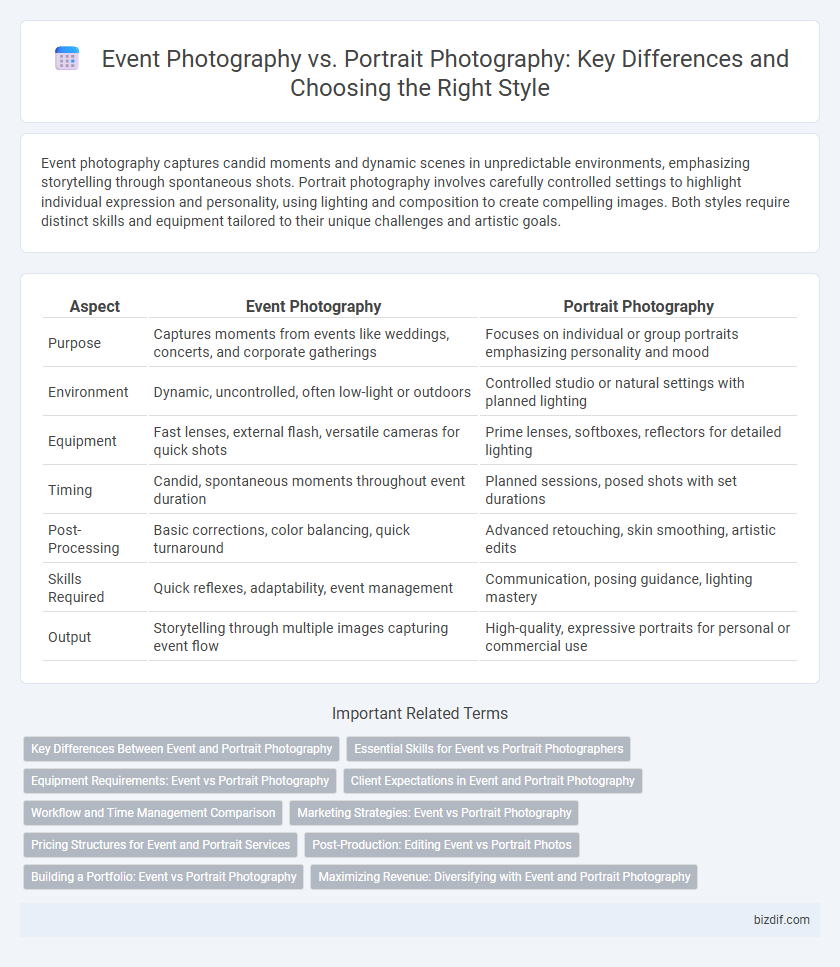Event photography captures candid moments and dynamic scenes in unpredictable environments, emphasizing storytelling through spontaneous shots. Portrait photography involves carefully controlled settings to highlight individual expression and personality, using lighting and composition to create compelling images. Both styles require distinct skills and equipment tailored to their unique challenges and artistic goals.
Table of Comparison
| Aspect | Event Photography | Portrait Photography |
|---|---|---|
| Purpose | Captures moments from events like weddings, concerts, and corporate gatherings | Focuses on individual or group portraits emphasizing personality and mood |
| Environment | Dynamic, uncontrolled, often low-light or outdoors | Controlled studio or natural settings with planned lighting |
| Equipment | Fast lenses, external flash, versatile cameras for quick shots | Prime lenses, softboxes, reflectors for detailed lighting |
| Timing | Candid, spontaneous moments throughout event duration | Planned sessions, posed shots with set durations |
| Post-Processing | Basic corrections, color balancing, quick turnaround | Advanced retouching, skin smoothing, artistic edits |
| Skills Required | Quick reflexes, adaptability, event management | Communication, posing guidance, lighting mastery |
| Output | Storytelling through multiple images capturing event flow | High-quality, expressive portraits for personal or commercial use |
Key Differences Between Event and Portrait Photography
Event photography captures candid moments and dynamic interactions in real-time, often requiring quick adjustments to varying lighting and environments. Portrait photography focuses on controlled settings, emphasizing posed compositions that highlight individual expressions and personality. The primary difference lies in event photography's spontaneity versus portrait photography's deliberate staging and detail-oriented approach.
Essential Skills for Event vs Portrait Photographers
Event photographers excel in adaptability and rapid decision-making, capturing spontaneous moments amidst dynamic environments. Portrait photographers master controlled lighting, precise posing, and deep client communication to evoke authentic expressions. Both disciplines require technical expertise and creativity, but event photography prioritizes situational awareness while portrait photography emphasizes personalized interaction.
Equipment Requirements: Event vs Portrait Photography
Event photography demands versatile equipment such as fast zoom lenses (24-70mm f/2.8) and reliable external flashes to adapt to dynamic lighting and spontaneous moments. Portrait photography typically requires prime lenses with wide apertures (85mm f/1.4 or 50mm f/1.8) and controlled lighting setups, including softboxes and reflectors, to achieve sharp focus and pleasing bokeh. Both styles benefit from sturdy tripods and high-performance cameras, but event photography prioritizes mobility and quick adjustments, while portrait photography emphasizes precision and controlled environments.
Client Expectations in Event and Portrait Photography
Clients expect event photography to capture dynamic moments and the overall atmosphere of the occasion, emphasizing candid shots and a broad narrative that documents interactions and key highlights. In portrait photography, clients prioritize controlled environments, focusing on personal expression, detailed lighting, and composition to highlight individual or group personalities. Understanding these differing client expectations is essential for photographers to tailor their techniques and deliver satisfying results in each genre.
Workflow and Time Management Comparison
Event photography demands rapid adaptability and efficient workflow to capture spontaneous moments, requiring photographers to manage multiple lighting conditions and subject dynamics simultaneously. Portrait photography allows for a more controlled environment where time management focuses on setting up lighting, guiding poses, and retouching, resulting in a slower but detail-oriented process. Optimizing workflow in event photography involves quick image selection and batch editing, whereas portrait photography benefits from meticulous post-processing and client consultations to enhance image quality.
Marketing Strategies: Event vs Portrait Photography
Event photography marketing strategies emphasize building relationships with venues, event planners, and corporate clients through targeted social media campaigns showcasing live action shots and client testimonials. Portrait photography marketing focuses on personal branding, leveraging SEO-optimized websites and local advertising to attract individuals seeking professional headshots or family portraits. Both approaches benefit from a strong online presence but differ in client engagement tactics and content presentation, reflecting the distinct nature of event and portrait services.
Pricing Structures for Event and Portrait Services
Event photography pricing typically involves hourly rates or package deals based on event duration and coverage scope, often including additional fees for equipment, assistants, or travel. Portrait photography pricing usually consists of fixed session fees combined with options for prints, digital files, and retouching services, allowing clients to customize their package according to preferred deliverables. Understanding these distinct pricing structures helps clients budget effectively while ensuring professional service tailored to their specific photographic needs.
Post-Production: Editing Event vs Portrait Photos
Post-production in event photography prioritizes quick color correction, noise reduction, and selective sharpening to enhance candid moments without compromising natural ambiance. Portrait photography editing involves detailed skin retouching, background blurring, and precise lighting adjustments to emphasize subject features and create polished, studio-quality images. Efficient workflow software like Adobe Lightroom supports batch processing for events, while Adobe Photoshop excels in intricate portrait retouching for flawless results.
Building a Portfolio: Event vs Portrait Photography
Building a portfolio for event photography requires showcasing diversity through candid moments, dynamic crowd interactions, and on-the-spot storytelling that captures the essence of live experiences. Conversely, portrait photography portfolios emphasize controlled environments, highlighting subject expressions, lighting techniques, and detail-oriented compositions to convey personality and mood. Selecting images that demonstrate technical skill, creativity, and versatility in each genre helps photographers attract targeted clients and establish a strong professional presence.
Maximizing Revenue: Diversifying with Event and Portrait Photography
Maximizing revenue in photography requires diversifying services between event photography and portrait photography to capture a broader client base. Event photography offers large-volume bookings through weddings, corporate gatherings, and concerts, providing steady income streams. Portrait photography complements this by delivering higher-margin, personalized sessions ideal for individuals and families seeking customized images.
Event Photography vs Portrait Photography Infographic

 bizdif.com
bizdif.com